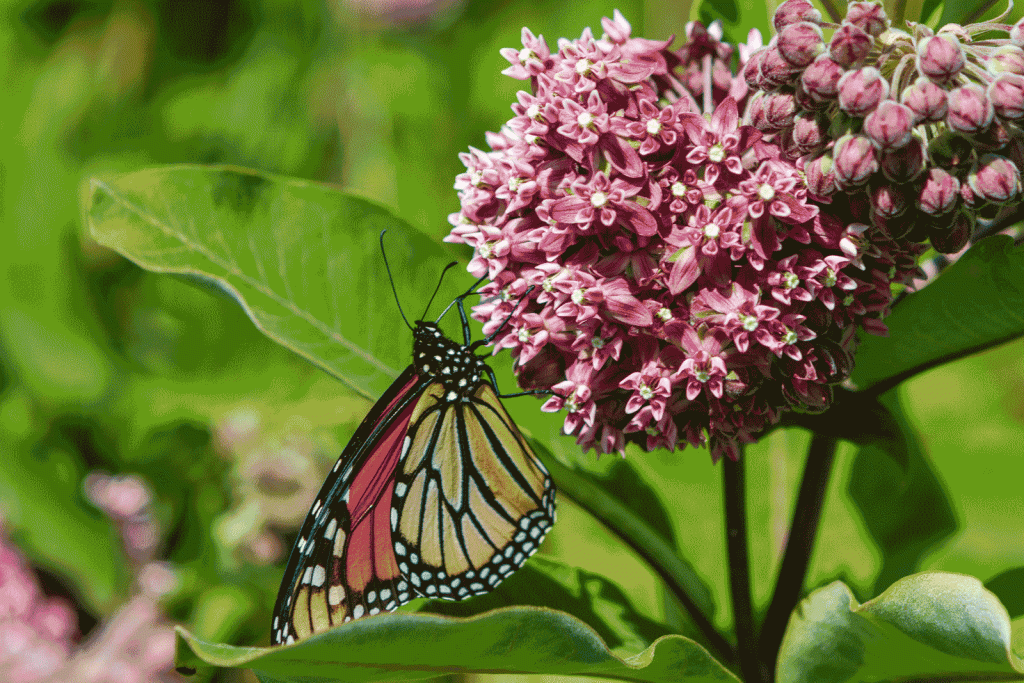
Monarch butterflies, with their iconic orange and black wings, are not only a symbol of natural beauty but also a vital component of our ecosystems. Unfortunately, monarch populations have declined dramatically in recent years due to habitat loss, climate change, and pesticide use. A key to reversing this trend lies in the conservation and restoration of one essential plant: milkweed.
Milkweed plays a critical role in the life cycle of monarch butterflies, and incorporating it into Conservation Reserve Program (CRP) projects can make a significant impact on their survival. Here’s why milkweed is so important and how you can use it to support monarch butterfly conservation through your CRP efforts.
Milkweed: The Monarch’s Lifeline
Milkweed isn’t just another wildflower; it’s the only host plant for monarch butterfly larvae. Adult monarchs lay their eggs exclusively on milkweed plants, and once the eggs hatch, the caterpillars feed on milkweed leaves to grow and develop. The plant contains compounds called cardenolides, which make monarch caterpillars and adults toxic to predators, providing a critical defense mechanism for their survival.
Without milkweed, the monarch life cycle cannot be completed. As milkweed habitats disappear, so do monarchs, making it essential to prioritize this plant in conservation efforts.
The Role of Milkweed in CRP Projects
The Conservation Reserve Program (CRP) provides an ideal opportunity to restore milkweed habitats across the U.S. By integrating milkweed into CRP plantings, landowners can help create critical habitat for monarchs while fulfilling conservation objectives such as:
Enhancing Biodiversity: Milkweed supports not only monarch butterflies but also a range of pollinators, including bees and other butterfly species.
Improving Soil Health: Like other native plants, milkweed helps prevent soil erosion and improves water infiltration, contributing to healthier ecosystems.
Supporting Ecosystem Balance: Milkweed plays a role in creating balanced ecosystems that promote wildlife diversity and sustainability.
Selecting Milkweed Species for Your Region
Milkweed species vary widely across the United States, so choosing regionally appropriate varieties is key to successful CRP plantings. Here are some common species and the regions they thrive in:
Common Milkweed (Asclepias syriaca): Found throughout much of the Midwest and Eastern U.S., it’s a hardy option for many CRP projects.
Swamp Milkweed (Asclepias incarnata): Prefers wetter soils and is excellent for riparian areas and low-lying land.
Butterfly Milkweed (Asclepias tuberosa): Known for its vibrant orange flowers, this species thrives in drier soils and is well-suited to prairies.
Showy Milkweed (Asclepias speciosa): A great option for the Western U.S., with eye-catching pink blooms.
Consulting with a seed provider like All Native Seed ensures you select the right milkweed species for your region’s soil, climate, and conservation goals.
Tips for Incorporating Milkweed into Your CRP Project
Include Milkweed in Diverse Seed Mixes
Combine milkweed with other native grasses and forbs to create a balanced ecosystem. This approach ensures your CRP planting supports a variety of pollinators and wildlife while providing the conditions monarchs need to thrive.
Prepare the Site Thoroughly
Proper site preparation is crucial for establishing milkweed. Remove existing weeds and prepare a seedbed that allows for good seed-to-soil contact. Milkweed seeds often require cold stratification, so planting at the right time is essential.
Plant in Clusters
Monarchs are more likely to locate milkweed when it’s planted in clusters. Group milkweed plants together to maximize their visibility and accessibility to butterflies.
Monitor and Maintain the Habitat
Regularly monitor your CRP site for invasive species that could compete with milkweed. Mowing, controlled burns, or targeted herbicide applications may be necessary to maintain the habitat’s health and diversity.
The Impact of Milkweed Conservation
By incorporating milkweed into your CRP projects, you’re not just planting a wildflower—you’re creating a lifeline for monarch butterflies. Restoring milkweed habitats can help reverse the decline of monarch populations, contributing to broader biodiversity and healthier ecosystems.
In addition to its ecological benefits, milkweed also adds visual appeal to CRP plantings with its striking flowers, making it a valuable addition to any conservation effort.
All Native Seed: Your Partner in Monarch Conservation
At All Native Seed, we provide high-quality milkweed seed and diverse seed mixes tailored for CRP projects. With over 400,000 acres of successful native plantings, we have the expertise and products to help you make a lasting impact on monarch butterfly conservation.
Our milkweed seed is carefully selected and tested to ensure purity and viability, giving you the best possible start for your CRP project. Whether you’re establishing a pollinator habitat or restoring native ecosystems, we’re here to guide you every step of the way.
Start Your Monarch Conservation Journey Today
Supporting monarch butterflies begins with planting milkweed. By integrating milkweed into your CRP projects, you can play a vital role in conserving these iconic pollinators while enhancing the environmental and economic value of your land.
Contact All Native Seed today to learn more about our milkweed seed and how we can help you achieve your conservation goals. Together, we can create a brighter future for monarchs and the ecosystems they call home.
